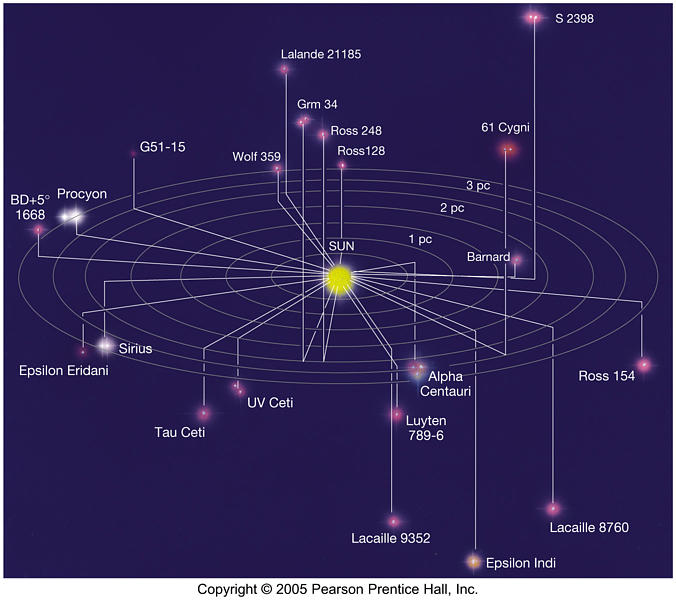


Stellar parallax illustrates how a branch of mathematics as terrestrial as 'geometry,' can be used in the service of celestial science. We'll begin with a famous illustration. Find an object that won't move, such as a tree, stop sign, cooperative spouse or northern New England economy. Close one eye and extend an index finger out in front of your face. Align the finger with the chosen background object. While keeping the finger steady, close the open eye and open the closed eye. You might notice that the finger's position relative to the background object shifted. If you extend the finger out to its maximum extent and repeat the demonstration,* you'll observe the shift is small. If you hold the index finger just in front of your face and repeat the demonstration, the shift will be quite large.

The apparent shift of an observed object's position resulting from a change of perspective is called "parallax." With the previous demonstration, we've established an inverse relationship. The closer the object, the greater the parallax angle.
We can apply the same principle to the stars. Astronomers can measure the position of a star relative to the background stars at one moment and then, in six months - when Earth is as far from its original orbital position as possible - the astronomers measure the star's location again. Provided the star is sufficiently close,** its parallax angle will yield its distance.

Without delving into all the delicious details pertaining to right angle trigonometry, we can share a simple equation relating the parallax angle and the distance. If the distance is expressed in parsecs - one parsec equals 3.26 light years - and the parallax angle is expressed in arc-seconds,*** the star's distance is 1 divided by the parallax angle.
For instance, let's say a star's parallax angle is 0.5." Its distance would therefore be 1/0.5" = 2.0 parsecs, or about 6.52 light years.
In 1838, Friedrich Wilhelm Bessel estimated the distance to the star 61 Cygni based on the observed parallax angle. Though his calculation of 10.3 light years was about ten percent less than the currently accepted value of 11.4 light years, Bessel was the first to successfully employ stellar parallax to measure a star's distance.
The Hipparcos satellite, launched by the European Space Agency in 1997, catalogued about 118,000 stars and their distances. The GAIA probe, launched in 2013, will calculate distances and positions of more than 1 billion stars within our region of the Milky Way Galaxy.
The parallax method, valid out to about 500 parsecs, is but one of the many celestial distance determination methods astronomers have developed. As we will discover, they now confidently know distances out to billions of light years. Throughout the remainder of this course we will be learning many of them.
Before we end today, let's address one immensely important question.
.jpg%22&N=unnamed (1).jpg)
How did astronomers know which stars to choose as foreground objects before they knew the distances to any of the stars?
That seems like a perfect example of placing the cart in front of the flying horse. One would think that they could have chosen the brightest stars under the assumption that the bright ones were the closest. That assumption, however, is based on the incorrect belief that the stars are of equal brightness. They certainly aren't. If they were, selecting the foreground stars would have been a trivial matter. Instead, astronomers correctly assumed that the closest stars would exhibit the highest proper motions! All stars move very rapidly. However, those closest to us would tend to appear to move more quickly through the sky than more distant stars. As an analogy, imagine your watching a car speed down the freeway. If you're standing close to the freeway, the car will appear to move very quickly. If you're far away from the freeway, the car will seem to move more slowly across your viewfield.
Just another example of the human ingenuity that has enabled astronomers to discover so much about the Universe without setting foot off this planet.
Quiz tomorrow.
Much more about stars next week.
*We could have referred to this exercise as a 'experiment,' except that it was nothing of the sort. Any exercise that will yield a known result is a demonstration. An exercise that will lead to a result that, though predicted, isn't certain, is an experiment.
**For ground based observations, the range has been about 500 parsecs. (A parsec equals about 3.26 light years.)
***One degree can be equally sub-divided into 60 arc-minutes. One arc-minute can be equally sub-divided into 60 arc-seconds. An arc-second is a particularly small angle.